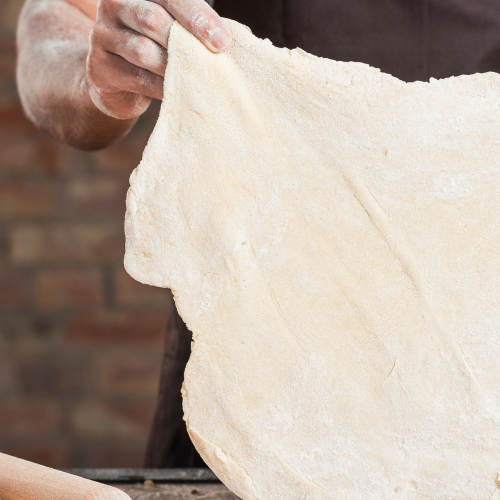Step-by-Step Guide:
Prepare the Dough:
In a large mixing bowl, dissolve the yeast in the warm water. Let it sit for about 5 minutes until it becomes frothy.
Add the flour to the yeast mixture and mix until a shaggy dough forms.
Add the salt and olive oil, then continue mixing until the ingredients are well incorporated.
Transfer the dough to a lightly floured surface and knead for about 10 minutes until smooth and elastic. Alternatively, you can use a stand mixer with a dough hook attachment on medium speed for about 5-7 minutes.
First Rise:
Place the dough in a lightly oiled bowl, cover with plastic wrap or a damp cloth, and let it rise at room temperature for about 2 hours, or until doubled in size.
Folding and Chilling:
Gently deflate the dough and perform a series of stretch and folds: stretch one side of the dough outward and fold it over the center, repeating on all four sides.
Cover the bowl again and refrigerate the dough for at least 1 hour, or up to 24 hours. This step develops flavor and makes the dough easier to handle.
Shaping the Dough:
Remove the dough from the refrigerator and let it sit at room temperature for about 30 minutes.
Transfer the dough to a well-floured surface and gently stretch it into a rectangular shape to fit your baking tray. Be careful not to deflate the air bubbles that have formed.
Place the stretched dough onto a parchment-lined or lightly oiled baking tray, adjusting it to fit the tray's dimensions.
Second Rise:
Cover the dough with a damp cloth and let it rise for another 30-45 minutes at room temperature until slightly puffy.
Preheat the Oven:
About 30 minutes before baking, preheat your oven to 250°C (482°F), or the highest temperature your oven can achieve.
Add Toppings:
Gently spread the tomato sauce over the surface of the dough, leaving a small border around the edges.
Distribute the mozzarella cheese evenly over the sauce.
Add any additional toppings as desired.
Bake the Pizza:
Place the baking tray in the preheated oven and bake for 10-15 minutes, or until the crust is golden and the cheese is bubbly and slightly browned.
Finish and Serve:
Remove the pizza from the oven and let it cool for a few minutes.
Drizzle with extra-virgin olive oil and garnish with fresh basil leaves.
Use a pizza cutter or sharp knife to cut the pizza into rectangular or square slices.
Serve warm and enjoy!
Variations and Tips:
Flour Options: While all-purpose or bread flour works well, using Italian Tipo '00' flour can yield a more authentic texture.
Hydration Level: An 80% hydration dough results in a light and airy crust. If you're new to high-hydration doughs, you might start with 70% hydration (280g water) to make the dough easier to handle.
Toppings: Feel free to experiment with various toppings such as sautéed vegetables, cured meats, or different cheeses. Traditional Roman toppings include ingredients like zucchini, prosciutto, and mushrooms.
Dietary Substitutions:
Gluten-Free: Use a gluten-free flour blend suitable for pizza dough. Note that hydration levels may vary, so adjust the water content as needed.
Vegan: Replace mozzarella with vegan cheese alternatives and ensure the dough is made without animal products.
